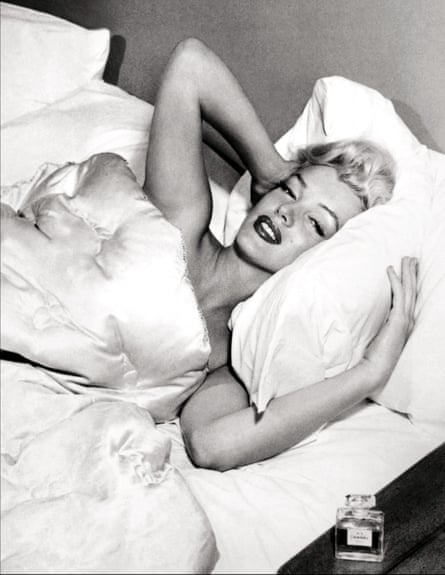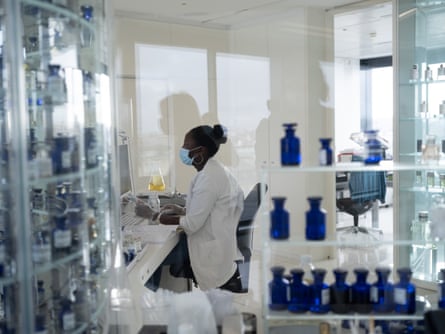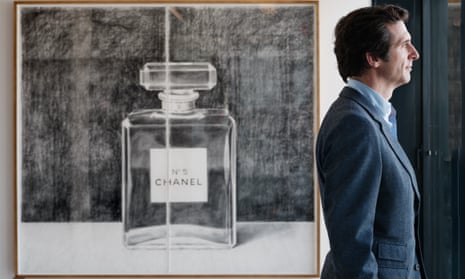Through the floor-to-ceiling windows of his seventh-floor office at Chanel’s chic Parisian HQ, Olivier Polge can look out over the French capital. From here, in the western suburb of Neuilly-sur-Seine, much of the city’s iconic skyline is in full view: the Eiffel Tower, mansard roofs, and the greenery of Bois de Boulogne; the Sacré-Cœur atop Montmartre opposite.
It’s a vista that has captivated some of Europe’s most celebrated visual minds, but from here Polge takes inspiration for another of his senses. He is, after all, the fashion house’s nose, Chanel’s perfumer-in-chief: the steward of its iconic scents past, and the man charged with creating their fragrances of the future.
His desk is precisely as you’d expect – handwritten notes and branches of blotters jut out from short metal stands, surrounded by boxes brimming with collections of indecipherably labelled small glass bottles. In each, he explains, is an ongoing experiment; constantly evolving concoctions which, he hopes, will one day lead him to another perfect perfume. Since taking the helm in 2015, Polge has created 17 scents: Chance Eau Vive and Gabrielle Essence Eau de Parfum among them. And, there’s No 5 L’Eau: his take on Chanel No 5, the global bestseller.
Each of his formulae is sent to the laboratory just next door, where a team of four technicians will carefully construct them. Ingredients sit inside their perfumer’s organ, the room’s centrepiece – a large, shelved glass cylinder in which raw materials are stored neatly in vials. There’s ylang-ylang, Rose de Mai and bergamot; citruses and at least 10 types of jasmine. The bottles are blue to protect them from potentially damaging sun rays, and each will quickly be returned to the temperature-controlled unit after use to stop any deterioration.

“It’s only once I collect a creation,” he says, “that I begin to truly assess the compound’s composition. And that’s by no means simply just how the fragrance feels initially.”
Each is sprayed on to a strip, on which the scent sits. As the liquid evaporates, Polge explains, the aroma is constantly evolving. He needs to sit with them. “Often,” he says, “I realise my conception isn’t quite right.” It takes repeated trials and testing. “The closer I get to the right formula, the longer I spend with the perfume. I need to understand its train, its scent signature; the wet and dry notes.”
It might take him weeks to know whether a certain iteration is correct: “I must be sure I won’t become bored of it.”
At Chanel, Polge tells me, the role of the nose is unique: elsewhere, his counterparts are primarily responsible for product development. Here, however, he also oversees all the house’s ongoing fragrance production. “All those perfumes have very specific raw materials which I have to gather year after year,” he says, “while ensuring we have each of these specific elements available and sustainable in the long term to keep going.”
At the heart of this operation sits Chanel No 5, the world’s most popular perfume. This year marks its centenary, in that time faces of the scent have included Nicole Kidman, Catherine Deneuve and, more recently, actor and activist Marion Cotillard. Now, for the first time, a book dedicated to exploring the perfume’s history has been published, celebrating this milestone.
The recipe itself is a closely guarded secret that has consistently remained unchanged, although more than 80 separate scents are said to be inside it. Many of the most precious elements are grown in-house by Chanel in Grasse, France’s historical perfume capital.

“The perfume industry is organised completely differently to, for example, wine,” says Polge. “People often ask, does No 5 change? Is the annual crop different? But we know exactly what it needs to smell like, and my job is to ensure it remains the way it’s always been.”
In early spring 1921, Gabrielle “Coco” Chanel approached perfumer Ernest Beaux – the house’s first nose – with her vision. She wanted him to create a fragrance like none that had come before it. She vowed to turn perfume into fashion. This was an era when smelling of something specific – gardenia, jasmine, rose – was en vogue. “Gabrielle didn’t want a perfume which simply smelled like a specific raw material,” says Polge, “she didn’t have the outlook of a traditional perfumer.”
Instead, she asked for something abstract: “an artificial fragrance like a dress,something crafted.”
It’s said that, after much hard work, something clicked when Chanel breathed in the scent of Beaux’s fifth sample. “Gabrielle Chanel had this idea that perfumes could be an expression of fashion,” says Polge, getting up from his desk to guide us towards the laboratory. “Before then, you had the world of perfumers and the world of designers – they weren’t connected. But Gabrielle thought no, this perfume – No 5 – will be the scent of Chanel. That’s why, before any other designers were doing the same, she put her name to it.”
Decades have passed since the scent was first bottled, in which time countless designers have followed suit: scents are routinely given their fashion house’s moniker; few smell of a single natural ingredient. No 5’s longevity, therefore, must be as much down to its past as its ever-evolving present.

“The success of a perfume is very much linked to the attention you put behind it,” Polge explains. “We know we make perfume today because of No 5, we always put it on a pedestal: we find a new character, a new story, a fresh face to embody the fragrance.”
Of course, the multi-million pound marketing campaigns play their part, but its story could never have been scripted. In her lifetime, Marilyn Monroe never appeared in a Chanel campaign, yet her 1952 comments in an interview with Life magazine may have been the perfume’s greatest advertisement. When asked what she wore to bed, Monroe replied: five drops of Chanel No 5 and nothing else. In many ways, says Polge, it has written its own narrative.
Standing in the centre of the light-filled lab, Polge picks out various containers, dunking dipsticks inside. Replaced regularly to ensure they’re at their best, each of the fragrances are pure and pungent. There’s sandalwood oil direct from New Caledonia in the South Pacific: deep, rich and earthy. There’s “jasmine-absolute” from Grasse itself: sweet and floral. Still, it’s not long before – with my untrained snout – they all start merging.

Polge has no such problems. There have only been four noses at Chanel. After Beaux came Henri Robert, then Jacques Polge: Olivier’s father. He shows me to the small library in the corner of the lab, the books curated and beautifully bound by Jacques before his departure.
“He joined when I was just four years old,” says Polge. “As far back as my conscious memory goes, scent was a constant presence.”
In typical teenage fashion, young Olivier spent his adolescence determined to do anything but follow in his father’s footsteps. He loved music, design and crafting, and enrolled on an art history course; during his first summer break he asked his father if they could spend a month in the lab together. “If you knew my father, you’d know he doesn’t speak too much,” Polge says. “That all changed when I arrived for the first time in the lab and he started to teach me.”
Polge returned to university the following September but soon turned up to the family home for dinner. “I told him I wanted to leave my studies and learn to become a perfumer,” recalls Polge. “At first he said it wasn’t a good idea, but within a few days he’d warmed to it.”
Rather than taking his son under his wing, Jacques insisted Olivier learn his craft in the field. He spent time in the factories, coming to understand the way raw materials are extracted, how they interact with each other. It was only 20 years later that Olivier would return to Chanel. Polge senior was ready to retire andhad been asked to prepare a list of potential candidates to take over. Given his son’s talent and prowess, he believed it would’ve been a mistake not to include Olivier, who’d spent years grafting. Soon enough, Polge junior was hired.

There’s nothing genetic, Polge says, that made him a suitable successor. A perfumer, he explains, shouldn’t smell things nobody else can, it’s not about possessing a palate that’s distinctly accurate: “We all have a huge memory of scent. The work is much more about activating the link between your nose and memory.”
“When I came back,” he says, “it was the first time I really felt I worked with my father. By this time, I knew how to create a perfume. But dad was showing me something special – the Chanel way; his explanation of our style. To everyone here, that’s incredibly important.”
Polge spent his first year not making a single perfume, instead he was told to watch how others worked around him. This meant spending time sitting in the lab, just as he’d done that first summer, while also coming to understand the design and development process inside Chanel’s ateliers.
It was Gabrielle Chanel who famously said that while fashion fades, only style remains the same. When it comes to perfumes, Polge says that couldn’t be truer. Season by season, garments come and go. A scent, meanwhile, must be enduring. It’s this that Polge keeps at the heart of his work. Not only to ensure the legacy of Chanel lives on, but that of his father, too.
Chanel No 5 by Pauline Dreyfus is published in the UK by Thames & Hudson and in the US by Abrams
